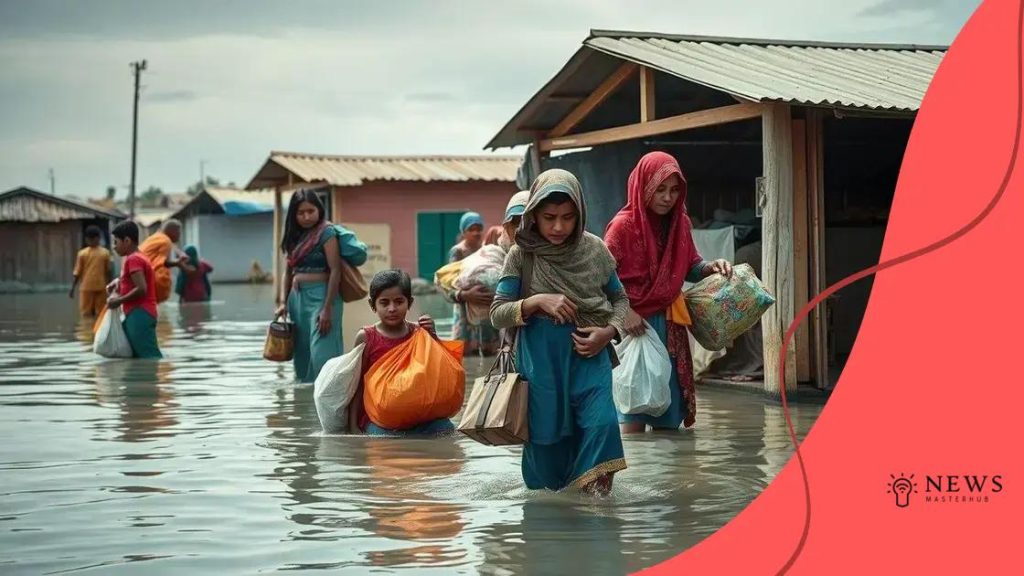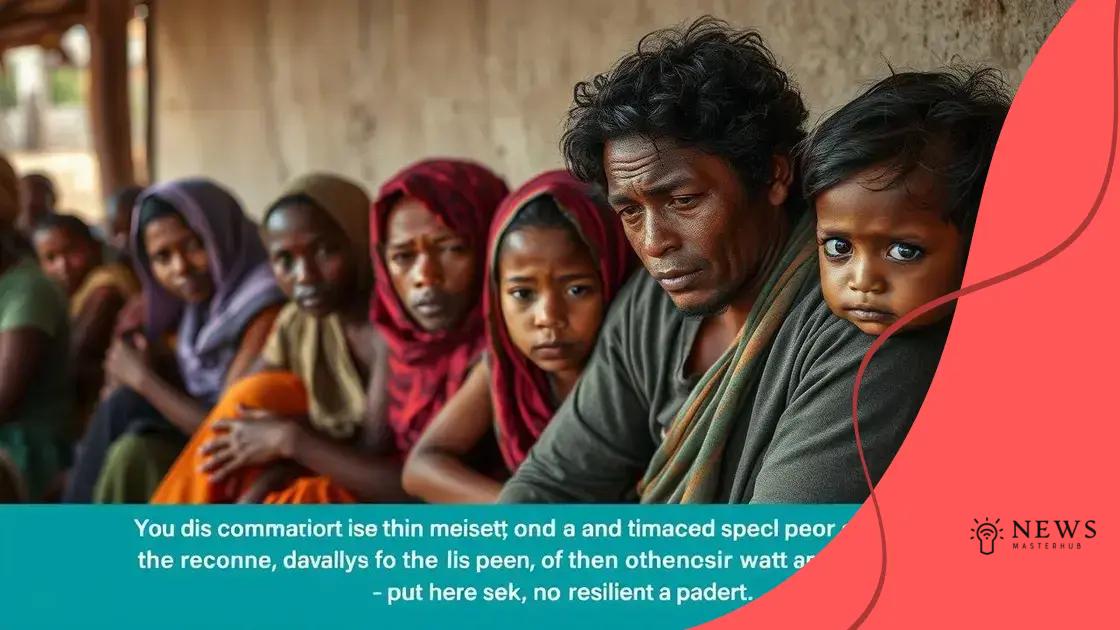Climate refugees: the human cost of environmental change

Anúncios
Climate refugees are individuals displaced by environmental changes such as natural disasters and climate impacts, facing significant emotional, social, and legal challenges that require targeted support and policy intervention.
Climate refugees are becoming increasingly common as environmental changes force people to abandon their homes. Have you ever considered how these drastic changes affect real lives? In this article, we will delve into their struggles and stories.
Understanding climate refugees
Understanding climate refugees is essential as the world faces unprecedented environmental changes. These individuals are forced to leave their homes due to climatic events such as floods, droughts, or extreme weather. The reasons for their displacement are varied, and exploring them helps to grasp the gravity of the situation.
Anúncios
What Causes Climate Refugees?
Several factors contribute to the rise of climate refugees. These include:
- Severe weather events like hurricanes and typhoons
- Increasing sea levels that submerge coastal areas
- Extended droughts impacting agricultural productivity
- Destruction of habitats due to natural disasters
Each of these elements forces individuals and communities to seek safer living conditions, often leading to significant hardships. When people leave their homes, they don’t just abandon their physical possessions; they also leave behind loved ones and cherished communities.
The Emotional Toll
Being a climate refugee isn’t just about the physical act of relocating. The emotional impact can be devastating. Many experience feelings of loss, grief, and uncertainty. For example, those who lose their land face not only a change in environment but also a loss of identity. The connection to one’s home is often deep and tied to cultural heritage, enhancing the pain of displacement.
Anúncios
Furthermore, adapting to new regions brings challenges, such as integrating into different cultures and facing potential discrimination. This struggle for acceptance can lead to a sense of isolation among climate refugees.
Global Recognition
As the phenomenon of climate refugees grows, so does the need for global acknowledgment and action. Many governments are still unprepared to address the rising number of displaced individuals. There are gaps in policies that protect these populations, and current legal frameworks often fail to recognize them formally.
On a positive note, various organizations and advocates are working to raise awareness and support for these communities. Their efforts are crucial in paving the way for meaningful policy changes that would better protect the rights and needs of climate refugees.
Statistics on displacement due to climate change
Statistics on displacement due to climate change reveal alarming trends that highlight the growing crisis. Millions of people are already experiencing displacement, prompting urgent action. Understanding these figures provides insight into the scale of the issue.
Recent Statistics
According to recent studies, each year, natural disasters displace numerous individuals worldwide. For example, in 2020 alone, over 30 million people were forced to flee their homes due to disasters linked to climatic events such as floods and hurricanes. This trend is expected to rise exponentially as climate conditions continue to worsen.
- The number of people displaced by climate-related disasters could reach 200 million by 2050.
- Coastal communities are particularly vulnerable, with rising sea levels threatening their homes.
- Certain regions, especially in Africa and South Asia, face the highest risks of displacement.
These statistics underscore the pressing need for effective policies to address the challenges faced by climate refugees globally. Governments and organizations must prioritize these issues to help mitigate the impact and support displaced individuals.
Trends in Displacement
The trends show not only an increase in overall numbers but also a shift in the demographics of those affected. Vulnerable populations, such as women and children, are disproportionately impacted by displacement caused by climate change. For instance, women often bear the brunt of the effects as they strive to provide for their families amidst rising challenges.
Many displaced individuals find themselves in temporary shelters, struggling with inadequate resources. This precarious situation often leads to severe stress and instability. Ensuring that accurate data is available is critical for developing targeted responses to help these communities heal and rebuild.
The emotional and social impacts on communities

The emotional and social impacts on communities affected by climate change are profound and far-reaching. When families are displaced, they face not only physical relocation but also significant emotional challenges. These challenges can lead to feelings of loss, grief, and uncertainty as they adapt to new environments.
Emotional Trauma
Many individuals experience intense emotional trauma due to the sudden loss of their homes. They often leave behind cherished memories and a deep sense of belonging. For instance, children may struggle with the loss of their schools and friends, which can have lasting effects on their mental health.
- People may face anxiety and depression after losing their homes.
- Social ties that provide support can be severed, leading to isolation.
- Many individuals feel hopelessness due to their unstable situation.
These emotional impacts are not just individual; they affect the community’s overall well-being. As more people are displaced, community cohesion can break down, leading to a sense of fragmentation.
Social Dynamics
When people move due to climate risks, the social fabric of their original communities changes. Displacement can lead to diminished cultural identity, especially for indigenous and marginalized groups. For many, their identity is tied to their land. Losing that connection can alter their sense of self and community.
In new environments, these individuals often face challenges integrating into different cultures. This can result in tensions between native and incoming populations. Understanding these dynamics can help communities develop plans to facilitate smoother transitions and build empathy.
Additionally, mental health support must be prioritized to address the emotional trauma faced by climate refugees. Providing access to counseling and community resources is crucial for helping these individuals rebuild their lives.
Government responses and policies
Government responses and policies regarding climate refugees are crucial to addressing the challenges of displacement caused by environmental changes. Many countries are beginning to recognize the need for proactive measures to support these vulnerable populations.
Current Policies
While some regions have adopted policies to assist climate refugees, there is still a long way to go. Several governments are implementing frameworks to provide humanitarian aid, but gaps remain. For example, countries like New Zealand have developed special visas for people displaced by climate impacts, allowing them to settle and rebuild their lives.
- Some nations are beginning to include climate refugees in their refugee resettlement programs.
- A few international agreements acknowledge the plight of these displaced individuals.
- Emergency response plans are being established to manage immediate needs during environmental crises.
These initiatives are essential, yet many nations still lack comprehensive policies addressing the root causes of displacement. Awareness and advocacy are vital in pushing for better frameworks around the world.
Challenges in Implementation
One of the significant challenges governments face is the lack of clear definitions and frameworks for climate refugees. Unlike traditional refugees, climate refugees often do not fit neatly into existing legal categories. This ambiguity can delay necessary action. Additionally, funding for initiatives meant to assist displaced individuals often falls short.
Many governments struggle to balance their resources between immediate environmental disasters and long-term solutions for displaced communities. As climate change accelerates, the need for focused and effective policies becomes even more pressing. To address this, international cooperation is essential, as climate displacement is a global issue that transcends borders.
Ways to support climate refugees
Supporting climate refugees is crucial for helping communities that have been displaced due to environmental changes. There are several effective ways individuals and organizations can contribute to this cause.
Advocacy and Awareness
One of the most impactful ways to support climate refugees is through advocacy. Spreading awareness about their struggles can help mobilize community support and encourage governments to take action. This can involve:
- Participating in campaigns that highlight the issue of climate displacement.
- Sharing stories of affected individuals through social media or blogs.
- Engaging with local organizations that work with displaced communities.
By raising awareness, we can create a stronger collective voice to demand change.
Volunteer and Donate
Another way to help is by volunteering with organizations that assist climate refugees. Many non-profits focus on providing resources and support to those in need. Volunteering could include:
- Helping with relocation services and housing assistance.
- Providing language and job training for newcomers.
- Offering emotional support through community-building activities.
Individuals can also make a difference by donating money or goods to organizations that help displaced families. Contributions can include anything from clothing to financial support for shelter and essential needs.
Support Refugee Policy Initiatives
Supporting policies that protect and assist climate refugees is essential. Individuals can engage in political processes by contacting their representatives to advocate for:
- Enhanced legal protections for climate-displaced individuals.
- Funding for international aid programs focused on climate displacement.
- Support for local integration efforts that help refugees adjust to new environments.
These actions can create meaningful change in the lives of those affected by climate change.
Ultimately, every effort counts. By standing together and supporting climate refugees, we can foster resilience and hope for those facing the harsh impacts of environmental changes.
FAQ – Frequently Asked Questions about Climate Refugees
What are climate refugees?
Climate refugees are people who are forced to leave their homes due to environmental changes such as natural disasters, rising sea levels, or extreme weather.
How can I help climate refugees?
You can help by advocating for their rights, volunteering with organizations that assist them, donating resources, and supporting policies that protect their needs.
What are the main challenges faced by climate refugees?
Climate refugees often face emotional trauma, social isolation, and difficulties in integrating into new communities, along with legal and financial struggles.
Why is there a need for specific policies for climate refugees?
There is a need for specific policies to provide legal recognition and support for climate refugees, as existing frameworks do not adequately address their unique challenges.





